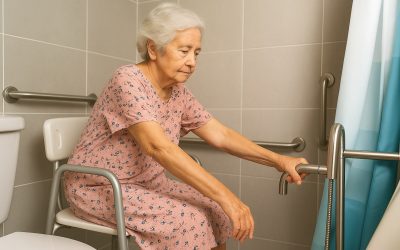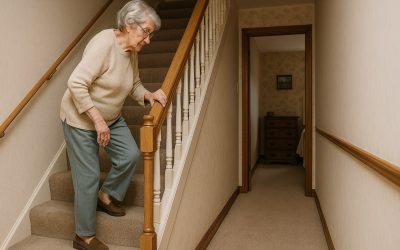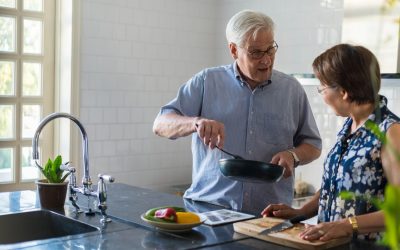As we age, the idea of staying in our own homes becomes more important than ever. There’s a sense of comfort and independence that comes with aging in place, but it also requires a few smart adjustments to keep things safe, accessible, and convenient. The good news? With a few modifications, you can make your home work for you—without sacrificing style or comfort. Let’s explore some of the best home upgrades that help seniors live safely and comfortably for years to come.
1. Install Grab Bars in Key Areas
Why It’s Important: Slips and falls are one of the biggest concerns for seniors, especially in bathrooms where surfaces get wet and slippery.
What You Can Do:
- Install grab bars near the toilet and in the shower to provide extra support.
- Choose bars with a textured grip for added security.
- Consider a vertical grab bar at the entrance of the shower for steadying yourself while stepping in.
Helen’s Tip: I added a grab bar next to my shower, and it gives me peace of mind every time I step in and out. It blends right in with the decor too!
2. Improve Lighting Throughout the Home
Why It’s Important: Good lighting is essential for preventing falls and making everyday tasks easier.
What You Can Do:
- Swap out dim bulbs for bright, energy-efficient LED lighting.
- Add nightlights in hallways, bathrooms, and near the bed for nighttime navigation.
- Install motion-sensor lights near entryways and staircases.
Helen’s Tip: I love my motion-sensor nightlight in the hallway—it turns on just when I need it and helps me avoid fumbling in the dark.
3. Replace Doorknobs with Lever Handles
Why It’s Important: Arthritis or reduced grip strength can make traditional round doorknobs difficult to turn.
What You Can Do:
- Swap out standard doorknobs for lever-style handles that are easier to push down.
- Look for handles with an ergonomic design for added comfort.
- Apply the same concept to cabinet handles and faucets for easier use.
Helen’s Tip: After switching to lever handles, I don’t have to struggle with my front door anymore—such a simple change, but it makes a world of difference!
4. Eliminate Trip Hazards
Why It’s Important: Clutter, loose rugs, and uneven flooring can create dangerous tripping hazards.
What You Can Do:
- Secure or remove area rugs, or use non-slip backing.
- Keep hallways and walkways free of clutter.
- Fix uneven flooring or transition strips between rooms.
Helen’s Tip: I swapped out my thick area rug for a low-profile one with non-slip backing—no more tripping, and it still looks great!
5. Upgrade the Bathroom for Safety and Comfort
Why It’s Important: The bathroom can be one of the most dangerous rooms in the house, but a few small upgrades can make it much safer.
What You Can Do:
- Install a walk-in shower with a built-in seat.
- Add a raised toilet seat to reduce strain on the knees.
- Use a handheld showerhead for better flexibility and ease of use.
Helen’s Tip: A raised toilet seat was a game-changer for me—so much easier on my joints, and it blends right in with the rest of the bathroom.
6. Consider a Stairlift or Ramps
Why It’s Important: Stairs can become difficult to navigate as mobility decreases.
What You Can Do:
- Install a stairlift if climbing stairs becomes too challenging.
- Add sturdy handrails on both sides of stairways.
- For homes with small steps leading to the entrance, a ramp can make entry much easier.
Helen’s Tip: A good friend of mine installed a ramp leading to her porch, and now she doesn’t have to worry about those tricky front steps anymore.
7. Create a First-Floor Living Space
Why It’s Important: If mobility issues arise, having essential living spaces on one floor can make daily life much easier.
What You Can Do:
- If possible, move the bedroom to the first floor.
- Set up a first-floor bathroom with a walk-in shower.
- Keep necessary items within reach to avoid frequent trips up and down the stairs.
Helen’s Tip: I moved my bedroom downstairs last year, and I couldn’t be happier. No more struggling with the stairs multiple times a day!
8. Use Smart Home Technology
Why It’s Important: Smart devices can add an extra layer of safety, convenience, and independence.
What You Can Do:
- Install a smart doorbell to see who’s at the door before answering.
- Use voice-controlled assistants like Alexa or Google Home to turn on lights, adjust the thermostat, or call for help.
- Set up automated reminders for medication or appointments.
Helen’s Tip: I set up a smart plug for my living room lamp—now I can turn it on and off just by using my voice. It’s a small change, but it makes my evenings so much easier.
Final Thoughts
Aging in place is about making your home work for you, not against you. With a few thoughtful modifications, you can maintain your independence and stay safe in the home you love.
Have you made any modifications to your home to make it more senior-friendly? I’d love to hear your tips—share them in the comments!




0 Comments